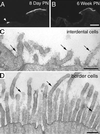Otoancorin, an inner ear protein restricted to the interface between the apical surface of sensory epithelia and their overlying acellular gels, is defective in autosomal recessive deafness DFNB22
- PMID: 11972037
- PMCID: PMC122933
- DOI: 10.1073/pnas.082515999
Otoancorin, an inner ear protein restricted to the interface between the apical surface of sensory epithelia and their overlying acellular gels, is defective in autosomal recessive deafness DFNB22
Abstract
A 3,673-bp murine cDNA predicted to encode a glycosylphosphatidylinositol-anchored protein of 1,088 amino acids was isolated during a study aimed at identifying transcripts specifically expressed in the inner ear. This inner ear-specific protein, otoancorin, shares weak homology with megakaryocyte potentiating factor/mesothelin precursor. Otoancorin is located at the interface between the apical surface of the inner ear sensory epithelia and their overlying acellular gels. In the cochlea, otoancorin is detected at two attachment zones of the tectorial membrane, a permanent one along the top of the spiral limbus and a transient one on the surface of the developing greater epithelial ridge. In the vestibule, otoancorin is present on the apical surface of nonsensory cells, where they contact the otoconial membranes and cupulae. The identification of the mutation (IVS12+2T>C) in the corresponding gene OTOA in one consanguineous Palestinian family affected by nonsyndromic recessive deafness DFNB22 assigns an essential function to otoancorin. We propose that otoancorin ensures the attachment of the inner ear acellular gels to the apical surface of the underlying nonsensory cells.
Figures







References
Publication types
MeSH terms
Substances
Associated data
- Actions
- Actions
Grants and funding
LinkOut - more resources
Full Text Sources
Other Literature Sources
Medical
Molecular Biology Databases
Miscellaneous

